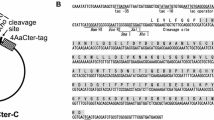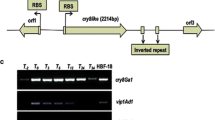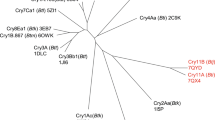Abstract
Two new crystal protein genes, cry24B and s1orf2, were cloned from a mosquitocidal Bacillus thuringiensis serovar sotto strain. The cry24B and s1orf2 genes encoded a 76-kDa and 62-kDa protein, respectively. The Cry24B protein retained five conserved regions commonly found in the existing Cry proteins. The amino acid sequence of the S1ORF2 had a high homology to that of the ORF2 protein of B. thuringiensis serovar jegathesan. Southern hybridization experiments with a cry24B gene-specific probe revealed that these genes are located on two large plasmids of > 100 kb. When the two genes, cry24B and s1orf2, were expressed in an acrystalliferous B. thuringiensis host, the proteins were synthesized and accumulated as inclusions. These inclusions exhibited no larvicidal activities against three mosquito species: Aedes aegypti, Anopheles stephensi, and Culex pipiens molestus. Likewise, the inclusions contained no cytocidal activity against HeLa cells.




Similar content being viewed by others
Literature Cited
Bradford MM (1976) A rapid and sensitive method for the quantification of microgram quantities of protein utilizing the principle of protein-dye binding. Anal Biochem 72:248–254
Crickmore N, Zeigler DR, Schnepf E, Van Rie J, Lereclus D, Baum J, et al. (2004) Bacillus thuringiensis toxin nomenclature. http://www.biols.susx.ac.uk/Home/Neil_Crickmore/Bt/index.html
Glare TR, O’Callaghan M (2000) Bacillus thuringiensis: Biology, ecology and safety. Chichester: Wiley
Heiss P, Bernatz S, Bruchelt G, Senekowitsch-Schmidtke R (1997) Cytotoxic effect of immunoconjugate composed of glucose-oxidase coupled to an anti-ganglioside (GD2) antibody on spheroids. Anticancer Res 17:3177–3178
Ito T, Sahara K, Bando H, Asano S (2002) Cloning and expression of novel crystal protein genes cry39A and 39 orf2 from Bacillus thuringiensis subsp. aizawai Bun1-14 encoding mosquitocidal proteins. J Insect Biotechnol Sericol 71:123–128
Juárez-Pérez V, Porcar M, Orduz S, Delécluse A (2003) Cry29A and Cry30A: Two novel δ-endotoxins isolated from Bacillus thuringiensis serovar medellin. Syst Appl Microbiol 26:502–504
Kawalek MD, Benjamin S, Lee HL, Gill SS (1995) Isolation and identification of novel toxins from a new mosquitocidal isolate from Malaysia, Bacillus thuringiensis subsp. jegathesan. Appl Environ Microbiol 61:2965–2969
Lee HK, Gill SS (1997) Molecular cloning and characterization of a novel mosquitocidal protein gene from Bacillus thuringiensis subsp. fukuokaensis. Appl Environ Microbiol 63:4664–4670
Lereclus D, Arantés O, Chaufaux J, Lecadet M (1989) Transformation and expression of a cloned δ-endotoxin gene in Bacillus thuringiensis. FEMS Microbiol Lett 51:211–217
Mizuki E, Park YS, Saitoh H, Yamashita S, Akao T, Higuchi K, et al. (2000) Parasporin, a human leukemic cell-recognizing parasporal protein of Bacillus thuringiensis. Clin Diagn Lab Immunol 7:625–634
Ohba M, Wasano N, Mizuki E (2000) Bacillus thuringiensis soil populations naturally occurring in the Ryukyus, a subtropic region of Japan. Microbiol Res 155:17–22
Ohgushi A, Wasano N, Shisa N, Saitoh H, Mizuki E, Maeda M, Ohba M (2003) Characterization of a mosquitocidal Bacillus thuringiensis serovar sotto strain isolated from Okinawa, Japan. J Appl Microbiol 95:982–989
Ohgushi A, Saitoh H, Wasano N, Ohba M (2005) A new insertion variant, IS231I, isolated from a mosquito-specific strain of Bacillus thuringiensis. Curr Microbiol in press
Orduz S, Diaz T, Thiéry I, Charles JF, Rojas W (1994) Crystal proteins from Bacillus thuringiensis serovar medellin. Appl Microbiol Biotechnol 40:794–799
Padua LE, Ohba M, Aizawa K (1984) Isolation of a Bacillus thuringiensis strain (serotype 8a:8b) highly and selectively toxic against mosquito larvae. J Invertebr Patho 185:12–17
Park HW, Delécluse A, Federici BA (2001) Construction and characterization of a recombinant Bacillus thuringiensis subsp. israelensis strain that produces Cry11B. J Invertebr Pathol 78:37–44
Rosso ML, Delécluse A (1997) Contribution of the 65-kilodalton protein encoded by the cloned gene cry19A to the mosquitocidal activity of Bacillus thuringiensis subsp. jegathesan. Appl Environ Microbiol 63:4449–4455
Saitoh H, Hwang SH, Park YS, Higuchi K, Mizuki E, Ohba M (2000) Cloning and characterization of a Bacillus thuringiensis serovar higo gene encoding a novel class of the δ-endotoxin protein, Cry27A, specifically active on the Anopheles mosquito. Syst Appl Microbiol 23:25–30
Seleena P, Lee HL, Lecadet MM (1995) A new serovar of Bacillus thuringiensis possessing 28a28c flagellar antigenic structure: Bacillus thuringiensis serovar jegathesan, selectively toxic against mosquito larvae. J Am Mosq Control Assoc 11:471–473
Thorne L, Garduno F, Thompson T, Decker D, Zounes M, Wild M, et al. (1986) Structural similarity between the Lepidoptera- and Diptera-specific insecticidal endotoxin genes of Bacillus thuringiensis subsp. “kurstaki” and “israelensis”. J Bacteriol 166:801–811
Ward ES, Ellar DJ (1987) Nucleotide sequence of a Bacillus thuringiensis var. israelensis gene encoding a 130 kDa delta-endotoxin. Nucleic Acids Res 15:7195
Yamashita S, Akao T, Mizuki E, Saitoh H, Higuchi K, Park YS, et al. (2000) Characterization of the anti -cancer-cell parasporal proteins of a Bacillus thuringiensis isolate, Can J Microbiol 46:913–919
Acknowledgments
We thank Dr. Daniel Zeigler and Dr. Neil Crickmore, Bacillus thuringiensis Pesticidal Crystal Protein Nomenclature Committee, for invaluable advice on the designation of the protein class. We also thank Dr. Minoru Maeda for support in in vitro cytotoxicity tests.
Author information
Authors and Affiliations
Corresponding author
Rights and permissions
About this article
Cite this article
Ohgushi, A., Saitoh, H., Wasano, N. et al. Cloning and Characterization of Two Novel Genes, cry24B and s1orf2, from a Mosquitocidal Strain of Bacillus thuringiensis serovar sotto. Curr Microbiol 51, 131–136 (2005). https://doi.org/10.1007/s00284-005-7529-3
Received:
Accepted:
Published:
Issue Date:
DOI: https://doi.org/10.1007/s00284-005-7529-3




